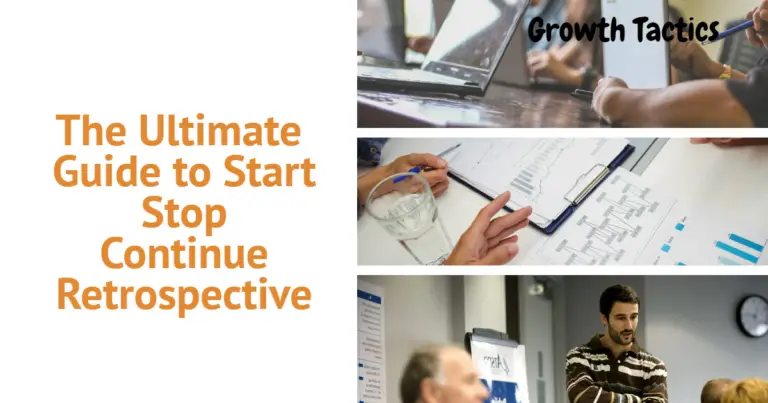A start stop continue retrospective is a team exercise that helps review what went well in a sprint or project, and find ways to improve in the next sprint or project.
It focuses on three elements:
- Start: Actions team members should start doing to improve team effectiveness and project execution.
- Stop: Things team members should stop doing that are not working or causing issues.
- Continue: Activities and behaviors team members should continue doing that are working well.
The start stop continue retrospective is commonly used in agile frameworks like Scrum to facilitate continuous improvement. At the end of each sprint, the team holds a retrospective meeting to reflect on what went well, what needs improvement, and actions they can take in the next sprint.
The start stop continue technique provides a simple framework for this reflection. It allows the team to identify the specific actions they should start, stop, and continue in order to improve performance, streamline workflows, boost team morale, and increase productivity.
By systematically reviewing what to start, stop, and continue, teams can focus their efforts on the activities that will have the biggest impact on project success. The start and stop elements help teams implement positive changes, while the continue piece reinforces what’s already working so those strengths can be built upon.

Jump To Section
When Should You Use the Start Stop Continue Technique?
The start stop continue retrospective technique is versatile and can be used for any recurring team review or retrospective, whether after sprints, milestones, projects, or on a regular cadence. It works well for both technical and non-technical teams across different industries.
Some examples of when to use start stop continue retrospectives:
- At the end of sprints or iterations in agile software development. The start stop continue format allows the team to reflect on what went well, what needs improvement, and what should continue in the next sprint.
- After completing a project or milestone. Looking back at the work completed so far helps identify successful practices as well as pain points to address in future phases of the project.
- On a regular basis such as monthly or quarterly. Regular retrospectives give teams the opportunity to continuously inspect and adapt their processes and collaboration.
- During organizational change. The start and stop categories can highlight what needs to change, while continue reminds the team of strengths.
- For ongoing team meetings or reviews. Start stop continue provides a simple framework for any recurring team sync to analyze what to start doing, stop doing, and continue doing.
- After team building activities or workshops. The technique integrates learnings and encourages putting new practices into action.
The versatility of start stop continue makes it a simple yet effective option for many different teams and situations where reflection on current practices is needed to improve future performance. The lightweight structure helps focus the conversation on actions for change.
How to Run a Start Stop Continue Retrospective
To run an effective start stop continue retrospective, there are a few key steps to follow:
Preparing the Materials Needed
The facilitator should gather the necessary materials ahead of time. This includes:
- Whiteboard or large flip chart paper
- Markers for writing
- Sticky notes for team members to write on
- Pens for each participant
- Printed start stop continue retrospective template (optional)
Setting up the space with these materials will allow for brainstorming, grouping ideas, and capturing feedback.
Setting Up the Space
Hold the retrospective in a meeting room with ample wall or whiteboard space. Arrange chairs so all team members can see each other and the writing surfaces.
Make sure markers, pens, sticky notes, and the start stop continue template are available for the team.
Assigning Team Member Roles
- Facilitator – Leads the retrospective by explaining the process, guiding discussion, and keeping things on track.
- Timekeeper – Watches the clock and lets the facilitator know when it’s time to move to the next step.
- Note taker – Documents the team’s ideas, action items, and takeaways from the retrospective.
Rotating these roles at each retrospective meeting encourages participation.
Facilitating the Retrospective
The facilitator leads the team through each step of the start stop continue framework:
- Explain the purpose of the retrospective and the process.
- Have each member reflect quietly on what to start, stop and continue.
- Invite team members to write ideas on sticky notes, one idea per note.
- As a group, organize the notes into themes.
- Discuss the grouped ideas and gain consensus on what to start, stop and continue.
- Prioritize the start and stop ideas, choosing 3-5 to take action on.
- Create an action plan for the selected items with owners and timelines.
- Close the meeting by summarizing key takeaways.
Following this facilitation process creates an engaging, collaborative retrospective.
Start Stop Continue Retrospective Template
The start stop continue retrospective template provides a simple framework to guide team discussions. Here is an overview of the standard template sections:
Overview of standard start stop continue template
The start stop continue template typically has three columns titled Start, Stop, and Continue. This provides a structure for team members to brainstorm ideas in each category.
- Start – This column is for new activities the team should begin doing.
- Stop – This column is for things the team should stop doing that are not working well.
- Continue – This column is for things that are going well that the team should continue doing.
Explain each section
The start section is for suggestions on new processes, activities, or behaviors the team should adopt. This allows the team to ideate on ways to improve.
The stop section is for capturing things that are not working or wasting time that the team should stop doing. This enables the team to eliminate ineffective practices.
The continue section is for highlighting positive aspects of the team’s workflow. This reinforces and maintains successful activities that should carry forward.
Share example template
Here is an example start stop continue retrospective template:
| Start | Stop | Continue |
|---|---|---|
| Daily standup meetings | Overscoping sprints | Code reviews |
| Automated testing | Skipping retrospectives | Sprint planning |
| Pair programming | Unclear requirements | Daily standups |
This simple start stop continue template provides the basic framework to facilitate an action-oriented retrospective. The team can brainstorm ideas under each column and discuss.

Start Stop Continue Retrospective Questions
The questions asked during a Start Stop Continue retrospective are critical for guiding productive discussions and eliciting helpful feedback from team members. The facilitator should prepare open-ended questions to spark conversations around the key areas of Start, Stop and Continue.
Questions to guide the start discussion
- What new processes, tools or activities should we start doing to improve our workflow?
- What initiatives or ideas do we want to begin implementing in the next sprint?
- What changes would help us achieve our goals more efficiently?
- What activities would boost our team morale or energy?
Questions to guide the stop discussion
- What processes or activities are no longer working for our team?
- What habits or behaviors are hindering our progress?
- What should we stop doing to eliminate frustration and wasted time?
- What initiatives have outlived their usefulness and should be abandoned?
Questions to guide the continue discussion
- What activities are working well that we should continue doing?
- What core processes give us the most value and should remain unchanged?
- What initiatives still have momentum and energy we want to sustain?
- What elements of our workflow should we keep doing as part of our regular routine?
Asking the right questions will lead to constructive suggestions and guide the team toward consensus on what to start, stop and continue. The facilitator may want to customize questions based on the team’s specific needs and goals for each retrospective.
Start Stop Continue Retrospective Example
Here is an example of how a start stop continue retrospective might look for a fictional software development team:
Start
- Start having a daily 15-minute standup meeting
- Start code reviews for all pull requests
- Start using feature flags to deploy code more incrementally
Stop
- Stop pointing fingers when bugs occur
- Stop committing directly to the main branch
Continue
- Continue with weekly sprint demos
- Continue pair programming when working on complex features
- Continue using the ticketing system to track work
In this example, the team has identified some new practices to start adopting, like daily standups and code reviews. They also want to stop certain behaviors that are causing problems, like finger-pointing and risky main branch commits. Finally, they want to continue practices that are working well already, like sprint demos and pair programming.
The output could be captured on a whiteboard or spreadsheet during the retrospective meeting, and then distributed to the team afterwards. Having the start/stop/continue items documented helps keep the team accountable and focused on the improvements identified. The list can be revisited in subsequent retrospectives to track progress.
This provides a fictional example of the types of action items that often come out of a start stop continue retrospective. The process helps teams reflect on what’s working, what’s not, and what they should change going forward.
Start Stop Continue Retrospective Variations
There are several ways to modify the start stop continue retrospective format to best suit your team’s needs:
Alternative Ways to Run the Retrospective
- Affinity mapping – Instead of grouping feedback into start, stop, continue, use an affinity mapping exercise. Have team members write ideas on sticky notes, then organize the notes into related groups. Look for themes and insights.
- Plus/Delta – Rather than start/stop/continue, have the team reflect on what went well (the plus) and what could be improved (the delta). This simpler framing can work well for some teams.
- 3 Ls – Use Liked, Lacked, Longed For as the categories for feedback instead of start/stop/continue. This framing elicits more emotional feedback.
Virtual Variations
- Digital whiteboards – If running the retrospective virtually, use a digital whiteboard like Miro or Mural instead of physical sticky notes. Break into virtual rooms for grouping.
- Anonymous feedback – To encourage candor in remote teams, set up an anonymous survey before the meeting to collect feedback. Review the themes during the retrospective.
- 1-on-1 conversations – For distributed teams, the facilitator may need to follow up a group virtual retrospective with 1-on-1 discussions to dig deeper into feedback.
Iterative Approaches
- Multiple rounds – Run multiple start/stop/continue cycles during the retrospective to drill down into details. Adjust actions between cycles.
- Recurring retrospectives – Hold start/stop/continue retrospectives at the end of each sprint or milestone rather than just once. This allows regular improvement.
- Review actions – At the next retrospective, start by reviewing the action items from the previous retrospective before the next start/stop/continue cycle.
Start Stop Continue Retrospective Benefits
The start stop continue retrospective provides several key benefits for teams:
- Improves team communication – By bringing everyone together to share honest feedback, the start stop continue retrospective opens up communication channels. Team members get to hear different perspectives and feel heard. This builds trust and transparency.
- Focuses on actionable outcomes – The start, stop, continue format pushes teams to identify specific actions they can take to improve. This prevents vague suggestions and focuses the conversation on steps team members can commit to.
- Promotes continuous improvement – Doing regular start stop continue retrospectives helps teams continuously improve. The retrospective gives teams a chance to regularly step back, review what’s working well, and find ways to improve. This builds a culture of learning.
Start Stop Continue Retrospective Challenges
The start stop continue retrospective can present some challenges that the facilitator should be aware of:
- Requires preparation and facilitation – To be effective, the start stop continue retrospective needs to be properly planned and facilitated. The facilitator should prepare the space, materials, and agenda ahead of time. They also need strong facilitation skills to keep the meeting on track, draw out participation from everyone, and summarize key insights. Without good facilitation, the retrospective can flounder.
- Team may struggle to provide honest feedback – Some team members may be hesitant to provide open and honest feedback, especially if there are tensions or dysfunctions within the team. The facilitator needs to set the right tone and create a psychologically safe environment. Setting clear guidelines around confidentiality and having 1-on-1 conversations beforehand can help.
- Hard to prioritize actions – With lots of input gathered, it can be challenging to distill this down into a prioritized list of actions. The facilitator needs to guide the team through a process of grouping, ranking, and decision-making to arrive at a reasonable set of actions that can realistically be accomplished.
Tips for an Effective Start Stop Continue Retrospective
A start stop continue retrospective can help teams continuously improve, but only if done effectively. Here are some tips:
Set the stage properly
The facilitator should explain the purpose and process clearly. Set expectations that the goal is open and honest feedback to improve team performance. Encourage all team members to participate and listen without judgment. Consider an icebreaker or warmup to get everyone engaged. Remind the team to focus comments on behaviors, not people.
Assign action items
Don’t end the retrospective without concrete next steps. Review the start and stop lists and agree on priorities. Then make specific action plans – who will do what by when. Document the actions and share them with the team. Assign ownership for each action item to ensure follow-through.
Follow up on action plans
Schedule time in the next retrospective to review progress on action items. Celebrate completed actions. For incomplete items, understand what’s blocking progress. Refine plans if needed and reset owners and timelines. Follow up regularly to maintain momentum.


